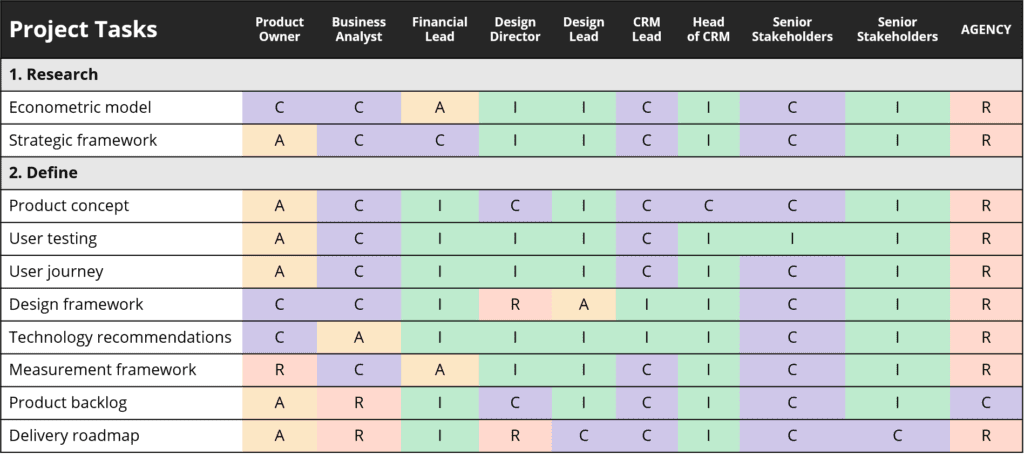Confusion around roles and responsibilities is a frequent problem in complex software development projects. It will cause significant challenges during the production stage and can bog the whole project down. That’s why many C-level managers use a RACI matrix — a straightforward and useful tool for outlining roles.
What is a RACI Matrix?
RACI matrix is a linear chart that helps distribute, organize, and monitor the execution of various tasks within a project. The responsibility matrix lays out tasks as rows and participating stakeholders (individuals or groups of people) as columns.
The chart further clarifies each stakeholders’ involvement according to four key roles:
- R — Responsible. A stakeholder in charge of completing a task. These people do the heavy lifting and share responsibilities for deliverables.
- A — Accountable (Authorized). A person who is directly accountable for results. This role oversees the progress and approves the task’s completion.
- C — Consulted. This role includes experts and advisors that give critical input about the work. Other parties need to consult with Cs’ before finalizing the task.
- I — Informed. These stakeholders must be regularly informed about the project’s milestones. They usually don’t contribute to the task directly, but should be kept in the loop regarding the progress.
Note: the RACI roles aren’t exclusive. One person (or a team) can assume one or more roles depending on the task.
Let’s take “application development” as an example. At the design phase, the product owner can assume both Accountable and Responsible roles in the RACI matrix. Likewise, the Development Team can be both Consulted and Informed during the product implementation stage.
RACI-VS
RACI-VS is another extension of the RACI model worth mentioning. As the name implies, it has two additional roles:
V — Verifies. Individuals who ensure that the project meets pre-established criteria.
S — Signs-off. People who have the final say in approving the deliverables. For instance, in IT outsourcing, this would be the role you assume as the customer.
How About an Example?
Below is a quick RACI matrix template, illustrating role/task distribution in a sample software development project:

When Using a RACI Model Makes the Most Sense?
When used correctly, a RACI matrix can help gain more clarity and alignment in complex software development projects, involving multiple stakeholders. As research suggests, this framework drove positive outcomes for companies such as Amazon, eBay, and the U.S. Department of Defense, among others.
While your company may not operate on the same scale, you’ll still find the responsibility matrix valuable in the following cases:
- For complex software projects with multiple development phases. Such projects usually include myriads of milestones, deadlines, and several iterations.
- During structural reorganizations as RACI helps ensure that no critical processes or function gets omitted.
- For the projects with numerous stakeholders, involved departments, and outsourced teams that need to be realigned with the rest of the operations.
- In cases when there are risks of confusion due to uneven roles, responsibilities, and workload distribution.
- When a team needs clarity over who has the final say for milestones and who signs-off a finished project.
The Benefits of RACI Matrix
As mentioned already, the RACI model helps get everyone across the board aligned and organized. This, in turn, brings in the following benefits:
- RACI framework helps improve communication between different teams/stakeholders by setting proper expectations regarding their input.
- RACI model streamlines the production by identifying and eliminating duplicate tasks (same task repeatedly performed by different stakeholders).
- It allows new team members to become aware of their role in the project from the get-go, which boosts their performance. According to a 2019 study by Effectory, employees who understand their role are 27% more efficient compared to those who lack clarity.
- The matrix gives stakeholders a chance to assess everyone’s workload and distribute it evenly across teams to avoid burnout.
- It ensures that each team member feels more responsible for the deliverables.
- It improves organizational maturity, which leads to a more effective decision-making process. As research from Deloitte suggests, employees in companies with higher organization design maturity can make better decisions without unnecessary delays.
Implementing RACI Matrix: Key Best Practices
As you can see, the RACI matrix adds organizational clarity to multi-facet projects. But there’s a catch: like any practice the RACI matrix needs to be adapted to and adopted in your company. Below are several practices to help you accomplish that.
Discuss Project Roles with Departments and Clients
RACI matrix efficiency largely depends on the accuracy of role distribution. Once you’ve established the key tasks for the project, set a series of meetings to discuss roles and responsibilities with all the participants.
Ask yourself this:
- Whose involvement is critical for project success?
- Whose lack of input can result in processual bottlenecks?
- Who should be held accountable for deliverables at each stage, why?
- Are we under-communicating important information to certain parties?
Having a series of discussions with different teams also helps address potential conflicts and ambiguities before they halt the project.
Lastly, remember that the RACI matrix isn’t set in stone. You can experiment with roles to create an optimal chart and maximize the department’s effectiveness.
Identify the Most Impactful Tasks
Prioritization is a key aspect of project management. It’s not enough to clarify who’s and how’s for each task. First of all, you should identify critical milestones during software development.
You should entrust the most experienced stakeholders for tasks with the biggest influence on the company’s resources and desired outcomes. In addition to that, you need to supply the A and R roles with clear guidelines to eliminate any ambiguities about essential milestones.
Ensure That Every Task Has Enough R’s and one A
Make sure that every task has at least one Responsible that does the core work. Then, ensure that there’s an Accountable stakeholder that oversees the process. But keep everything balanced. Too many or too few R’s can slow down the project.
Moreover, it’s better to avoid multiple Accountable parties. Having numerous stakeholders in charge can lead to conflicts and delayed decision-making.
Also, not every task requires every stakeholder’s participation. You can determine the Accountable and Responsible parties and skip I’s or C’s entirely for some tasks.
Avoid Too Many C’s
Having too many concerned parties halts any project. If your RACI chart features too many Consultants, consider changing their role to Informant. Doing so can help prevent micromanagement, scope creep, bottlenecks, and redundant consultations for each task.
To Conclude
The goal of the RACI matrix is to minimize ambiguities over who’s responsible for doing what task. During complex software development projects, a RACI matrix can help ensure that all parties involved know when their input is needed and act upon that. As a result, personal accountability increases, as well as the overall pace of execution.
Edvantis team would be delighted to further advise you on improving the efficiency of your software development process. Contact us for a free consultation!

